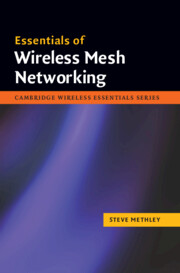Book contents
- Frontmatter
- Contents
- Preface
- Acknowledgements
- 1 Mesh overview and terminology
- 2 Attractive mesh attributes and applications
- 3 Fundamentals of mesh technology
- 4 Mesh capacity, scalability and efficiency – hypothesis testing
- 5 Mesh susceptibility
- 6 Mesh services and quality of service
- 7 Summary of potential mesh pitfalls to avoid
- 8 Appropriate telecommunications applications for mesh
- 9 Successful mesh implementations
- 10 Wireless sensor networks (WSNs) as mesh networks
- Abbreviations
- Selected definitions
- Appendix: Mobility models
- About the author
- Index
- Mesh hints and tips
8 - Appropriate telecommunications applications for mesh
Published online by Cambridge University Press: 01 March 2010
- Frontmatter
- Contents
- Preface
- Acknowledgements
- 1 Mesh overview and terminology
- 2 Attractive mesh attributes and applications
- 3 Fundamentals of mesh technology
- 4 Mesh capacity, scalability and efficiency – hypothesis testing
- 5 Mesh susceptibility
- 6 Mesh services and quality of service
- 7 Summary of potential mesh pitfalls to avoid
- 8 Appropriate telecommunications applications for mesh
- 9 Successful mesh implementations
- 10 Wireless sensor networks (WSNs) as mesh networks
- Abbreviations
- Selected definitions
- Appendix: Mobility models
- About the author
- Index
- Mesh hints and tips
Summary
To summarise once more, at this point in the book it has been shown that practical mobile meshes are not chosen primarily for spectral efficiency nor for any notion of self-generation of capacity. Meshes should be chosen because they have other benefits. Section 2.2 provided an introduction to how meshes offer coverage benefits, which is possibly their major attribute. In this chapter we revisit our six most likely applications which we have been considering throughout the book. These are
cellular multi-hopping or WiFi hotspot extension,
community networking,
home and office indoor networking,
micro base station backhaul,
vehicle ad hoc networks (VANETs), and
wireless sensor networks (WSNs).
The first five applications are considered in detail in this chapter, whilst wireless sensor networks receive their own treatment in Chapter 10, since they have some unique features. In this chapter, we also look at the barriers to mesh adoption and the time scales likely for them to be overcome.
For the following discussion we find it useful to group the applications into those which form a mesh on the user side and those which form a mesh on the network side, in other words those where the users' nodes themselves mesh together, versus those where only the backhaul forms a mesh. There is one case where the mesh can be for both users and network backhaul; this occurs in VANETs.
- Type
- Chapter
- Information
- Essentials of Wireless Mesh Networking , pp. 158 - 168Publisher: Cambridge University PressPrint publication year: 2009



